DMM TOC > 200 Commercial Letters and Cards201 Physical Standards1.0 Physical Standards for Machinable Letters and Cards 2.0 Physical Standards for Nonmachinable Letters 3.0 Physical Standards for Machinable and Automation Letters and Cards 1.0 Physical Standards for Machinable Letters and Cards1.1 Physical Standards for Machinable Letters1.1.1 Dimensional Standards for LettersMachinable letter-size mail is: a. Not less than 5 inches long, 3-1/2 inches high, and 0.007-inch thick. 1. 0.007 inch thick if no more than 4-1/4 inches high and 6 inches long; or 2. 0.009 inch thick if more than 4-1/4 inches high or 6 inches long, or both. b. Not more than 11-1/2 inches long, or more than 6-1/8 inches high, or greater than 1/4-inch thick. c. Rectangular, with four square corners and parallel opposite sides. Letter-size, card-type mailpieces made of cardstock may have finished corners that do not exceed a radius of 0.125 inch (1/8 inch). See Exhibit 1.1.1e. d. Within an aspect ratio (length divided by height) of 1.3 to 2.5, inclusive. See 601.1.4. e. Subject to additional dimensional restrictions in 3.0, depending on mailpiece design. Exhibit 1.1.1e Maximum Corner Radius for Letter-Size, Card-Type Mailpieces1.1.2 Weight Standards for Machinable LettersThe maximum weight for Presorted First-Class Mail machinable letters is 3.3 ounces (0.2063 pound). The maximum weight for Standard Mail machinable letters is 3.3 ounces (0.2063 pound). 1.1.3 All Machinable LettersAll machinable letters must meet the additional standards for automation-compatible letters in 3.0. 1.2 Physical Standards for Cards Claimed at Card Prices1.2.1 Dimensional Standards for CardsEach card (each stamped card or postcard or each half of a double stamped card or postcard) claimed at a card price must be: a. Not less than 3-1/2 inches high, 5 inches long, and 0.007 inch thick. b. Not more than 4-1/4 inches high, or more than 6 inches long, or greater than 0.016 inch thick. c. Rectangular, with four square corners and parallel opposite sides. Card-size pieces meeting the standards in 1.2.1 may have finished corners that do not exceed a radius of 0.125 inch (1/8 inch). See Exhibit 1.1.1e. 1.2.2 Other CardsA card that does not meet the applicable standards in 1.2 must not bear the words “Postcard” or “Double Postcard.” 1.2.3 Paper or CardstockA card must be of uniform thickness and made of unfolded and uncreased paper or cardstock of approximately the quality and weight of a stamped card (i.e., a card available from the USPS). A card must be formed either of one piece of paper or cardstock or of two pieces of paper permanently and uniformly bonded together. The stock used for a card may be of any color or surface that permits the legible printing of the address, postmark, and any required markings. 1.2.4 Acceptable AttachmentsA card may bear an attachment that is: a. A paper label, such as a wafer seal or decal affixed with permanent adhesive to the back side of the card, or within the message area on the address side (see 1.2.6), or to the left of the address block. b. A label affixed with permanent adhesive for showing the delivery or return address. c. A small reusable seal or decal prepared with pressure-sensitive and nonremovable adhesive that is intended to be removed from the first half of a double card and applied to the reply half. 1.2.5 Unacceptable AttachmentA card may not bear an attachment that is: b. Not totally adhered to the card surface. c. An encumbrance to postal processing. 1.2.6 Address Side of CardsThe address side of a card is the side bearing the delivery address and postage. The address side may be formatted to contain a message area. Cards that do not contain a message area on the address side are subject to the applicable standards for the price claimed. For the purposes of 1.2, miscellaneous graphics or printing, such as symbols, logos, or characters, that appear on the address side of cards not containing a message area are generally acceptable provided the items are not intended to convey a message. Cards claimed at the Presorted or automation card prices that contain a message area on the address side must be divided vertically or horizontally and meet the following additional standards, as applicable: 1. The address side of the card must be divided into a right portion and a left portion, with or without a vertical rule. The left portion is the message area. 2. The delivery address, postage, and any USPS marking or endorsement must appear in the right portion. The right portion must be at least 2-1/8 inches wide (measured from the right edge of the card, top to bottom inclusive). 3. For cards claimed at the Presorted price, nondelivery address information may extend into the right portion only above the address block and if the information is shaded or surrounded by a border that has at least 1/8 inch clearance between the delivery address block and the border. Mailers may choose not to shade or border the nondelivery address information if there is at least 1/8 inch of clear space around the delivery address block. 4. For cards claimed at the automation price, the standards for automation-compatible mail in 3.0, and 202.5.0, must be met. b. Horizontally divided cards. 1. The address side of the card must be divided into an upper portion and a lower portion, with or without a horizontal rule. The portion of the address side that does not contain the delivery address is the message area. 2. The delivery address, postage, and any USPS marking or endorsement must appear within the portion containing the delivery address. As an alternative, when the delivery address appears within the lower portion, it is permissible for the postage, return address, and any USPS marking or endorsement to appear in the upper portion. The portion bearing the delivery address must be at least 1-1/2 inches high (measured from the top or bottom edge of the card, as applicable, right edge to left edge inclusive). 3. For cards claimed at the Presorted price, nondelivery address information may extend into the portion containing the delivery address only if it appears above the address block and if the information is shaded or surrounded by a border that has at least 1/8 inch clearance between the delivery address block and the border. Mailers may choose not to shade or border the nondelivery address information if there is at least 1/8 inch of clear space around the delivery address block. 4. For cards claimed at the automation price, the standards for automation-compatible mail in 3.0, and 202.5.0, must be met. 1.2.7 Tearing GuidesA card may have perforations or tearing guides if they do not eliminate or interfere with any address element, postage, marking, or endorsement and do not impair the physical integrity of the card. 1.2.8 Double CardsA double card (a double stamped card or double postcard) consists of two attached cards, one of which is designed to be detached by the recipient and returned by mail as a single card. Double cards are subject to these standards: a. The reply half of a double card must be used for reply only and may not be used to convey a message to the original addressee or to send statements of account. The reply half may be formatted for response purposes (e.g., contain blocks for completion by the addressee). b. A double card must be folded before mailing and prepared so that the address on the reply half is on the inside when the double card is originally mailed. The address side of the reply half may be prepared as business reply mail, courtesy reply mail, meter reply mail, or as a merchandise return service label. c. Plain stickers, seals, or a single wire stitch (staple) may be used to fasten the open edge at the top or bottom once the card is folded if affixed so that the inner surfaces of the cards can be readily examined. Fasteners must be affixed according to the applicable preparation requirements for the price claimed. Any sealing on the left and right sides of the cards, no matter the sealing process used, is not permitted. d. The first half of a double card must be detached when the reply half is mailed for return. 1.2.9 Enclosures in Double CardsEnclosures in double postcards are prohibited at card prices. 2.0 Physical Standards for Nonmachinable Letters2.1 Criteria for Nonmachinable LettersA letter-size piece is nonmachinable if it has an exterior surface that is not made of paper or if it does not meet the standards in 3.0. Windows in envelopes made of paper do not make mailpieces nonmachinable. Attachments do not render mailpieces nonmachinable if allowed by eligibility standards according to the class of mail and if not prohibited in 3.0. In addition, a letter-size piece is nonmachinable if it weighs more than 3.3 ounces, unless it has a barcode, weighs no more than 3.5 ounces, and is eligible for and claims automation letter prices or Standard Mail Carrier Route (barcoded) letter prices. 2.2 Additional Criteria for First-Class Mail Nonmachinable LettersLetter-size pieces (except cards) that meet one or more of the nonmachinable characteristics in 2.1 are subject to the nonmachinable surcharge (see 233.1.4). All letter-size pieces over 3.5 ounces are prepared as letters and charged the flat-size prices. An envelope weighing no more than one ounce with one enclosed standard optical disc no larger than 12 centimeters in diameter, that is mailed to or from a subscriber as part of a round-trip mailing under 233.2.8 and 505.1.0 (or 507.1.0), is not subject to the nonmachinable surcharge. 2.3 Additional Criteria for Standard Mail Nonmachinable LettersThe nonmachinable prices in 243.1.0 apply to Standard Mail letter-size pieces that have one or more of the nonmachinable characteristics in 2.1. Mailers must prepare all nonmachinable letters as described in 245.5.0. 2.4 Additional Criteria for Periodicals Nonmachinable LettersThe nonbarcoded letter prices in 707 apply to Periodicals letter-size pieces that have one or more of the nonmachinable characteristics in 2.1. 2.5 Priority Mail Express, Priority Mail, and Critical Mail LettersMailers are encouraged, but not required, to design and produce Priority Mail Express and Priority Mail letter-size pieces as machinable letters. Critical Mail letter-size pieces (see 223) that do not meet machinable letter standards in 1.0 and 3.0 are not eligible for Critical Mail letter prices, but are eligible for Priority Mail Commercial Plus Flat Rate Envelope prices. 3.0 Physical Standards for Machinable and Automation Letters and Cards3.1 Basic Standards for Automation Letters and CardsLetters and cards claimed at any machinable, automation, or Standard Mail carrier route price, must meet the standards in 3.0. Unless prepared as a folded self-mailer, booklet, or postcard under 3.14 through 3.17, each machinable or automation letter must be a sealed envelope (the preferred method) or unenveloped. If unenveloped, each letter must be sealed or glued completely along all four sides or prepared under 3.15. 3.2 Paper WeightMailpieces should be constructed from high tear strength paper stock. All references in 3.0 to paper basis weight are for book-grade paper unless otherwise stated. The conversion table in Exhibit 3.2 provides a paper basis weight cross-reference. Exhibit 3.2 Paper Basis Weight Conversion Table 3.3 Dimensions and ShapeEach machinable or automation letter-sized piece must be rectangular (see 1.1.1) and must meet the following standards (see 3.15 for booklets): a. For height, no more than 6-1/8 or less than 3-1/2 inches high. b. For length, no more than 11-1/2 or less than 5 inches long. c. For thickness, no more than 0.25 or less than 1. 0.007 inch thick if no more than 4-1/4 inches high and 6 inches long; or 2. 0.009 inch thick if more than 4-1/4 inches high or 6 inches long, or both. 3.4 Standards for Letter-Size Pieces Containing One Disc (CD or DVD)3.4.1 Basic Standards for One Disc in a Letter-Size MailpieceA letter-size mailpiece containing one disc and meeting the general standards in 3.0 and the specific standards in 3.4.3 is considered automation-compatible. A mailpiece with one enclosed disc not meeting these standards must be tested and approved for automation-compatibility. For this purpose, mailers must submit 5 sample mailpieces and a written request to the local postmaster or business mail entry manager for submission to the Pricing and Classification Service Center (PCSC). 3.4.2 Disc Size and PlacementPosition the disc symmetrically at the vertical centerline and as near to the top edge of the mailpiece as is practical. Secure the disc to prevent it from shifting more than 1/2 inch in any direction. The maximum disc size is: a. 120 mm (4.7 inches) in diameter. b. 2 mm (0.08 inch) in thickness. 3.4.3 Dimensions and Other Physical Standards for Automation-Compatible Enveloped Letters Containing DiscsEach enveloped letter must meet the basic standards for machinable letters in 1.0 and have the following characteristics: a. Height, not more than 6 inches or less than 5.5 inches high. b. Length, not more than 9.75 inches or less than 7.25 inches long. c. Thickness, not more than 0.25 inch or less than 0.009 inch thick. d. Weight, not more than 3 ounces. e. A piece up to 8 inches long must be made of paper with a minimum 70-pound basis weight or equivalent. f. A piece over 8 inches long (up to 9.75 inches long) must be made of paper with a minimum 80-pound basis weight or equivalent. g. Discs in mailpieces made of the minimum basis weight paper must be inserted into a protective sleeve. h. Not be a window envelope, unless tested and approved under 3.4.1. 3.4.4 Dimensions and Shape Standards for Automation-Compatible Unenveloped Disc CarriersEach unenveloped disc carrier must meet the basic standards for machinable letters in 1.0 and have the following characteristics: a. Height, not more than 6 inches or less than 5.5 inches high. b. Length, not more than 9.75 inches or less than 7.25 inches long. c. Thickness, not more than 0.25 inch or less than 0.009 inch thick. d. Weight, not more than 3 ounces. e. Be prepared from paper stock meeting the industry standard for a basis weight of 75 pounds or greater, with none less than 71.25 pounds (measured weight for 500 25- by 38-inch sheets). The stock must be free from groundwood unless coated with a substance adding to the stock's ability to resist an applied bending force. f. Any folds or perforations in the mailpiece must be parallel to the address. g. Must meet the tabbing requirements for pieces prepared with folds or perforations parallel to the address provided in 3.14. 3.4.5 Unacceptable Characteristics for Automation-Compatible Letter-Size Pieces with DiscsDiscs in letter-sized envelopes and unenveloped disc carriers may not be enclosed in: packaging such as plastic "clamshells,” “plastic” “jewel cases,” or inflexible cardboard sleeves. 3.5 Maximum Weight, Machinable and Automation Letters and CardsThe following maximum weight limits apply: a. Critical Mail letters - 3 ounces. b. Booklets and unenveloped disc carriers - 3 ounces. c. Machinable enveloped letters and cards - 3.3 ounces. d. Automation enveloped letters and cards - 3.5 ounces (see 3.6 for pieces over 3 ounces.) 3.6 Heavy Letter Mail (over 3 ounces)Heavy letter mail (letter-size pieces over 3 ounces) must be prepared in a sealed envelope, may not contain stiff enclosures, and must have an 11-digit delivery point POSTNET or an Intelligent Mail barcode with a routing code in the address block (see 202.5.0). 3.7 Aspect RatioThe aspect ratio (length of the mailpiece divided by height) must be between 1.3 and 2.5, inclusive. Length and height are defined in 601.1.4. 3.8 Wraps and ClosuresAn automation-compatible mailpiece may not be polywrapped, polybagged, or shrinkwrapped; have clasps, strings, buttons, or similar closure devices; or have protrusions that might impede or damage the mail or mail processing equipment. 3.9 Staples and Saddle StitchingStaples or saddle stitching may be used only on booklet-type mailpieces to join the bound edge (spine). Inserted staples or stitching must parallel the bound edge, seat tightly and securely, and have no protrusions that might impede or damage the mail or mail processing equipment. 3.10 Rigid and Odd-Shaped ItemsRigid items (e.g., pens, pencils, keys, bottle caps) are prohibited within mailpieces. Reasonably flexible items (e.g., credit cards) are permitted. Subject to 3.12, odd-shaped items (e.g., coins and tokens) are permitted if firmly affixed to and wrapped within the contents of the mailpiece and envelope to streamline the shape of the mailpiece for automated processing. 3.11 Tabs, Tape, and GlueTabs may be made of paper, translucent paper, vinyl or plastic. Cellophane tape may be used as a closure when the saw-toothed cut edge is placed parallel to the edge being sealed. Tabs must not contain perforations. For tab size and placement for folded self-mailers see 3.14; for booklets see 3.15. Tab placement is subject to 1/4 inch variance in either direction. The following standards also apply: a. Translucent paper tabs should be made of paper with a minimum of 40-pound basis weight. b. Opaque paper tabs should be made of a minimum of 60-pound basis weight paper with a tear strength of at least 56 grams of force in the machine direction (MD) and 60 grams of force in the cross direction (CD). c. When a barcode clear zone is required under 202.5.1, tabs in the barcode clear zone must have a paper face meeting the standards for background reflectance and, if the barcode is not preprinted by the mailer, the standards for acceptance of water-based ink. d. Vinyl tabs and cellophane tape closures are not acceptable within the barcode clear zone. e. Tabs must be tight against the edge of the mailpiece. A maximum 1/16-inch overhang is recommended. f. Glue spots may be used in lieu of tabs (as indicated in Exhibit 3.16.5 through Exhibit 3.16.8) and must be placed within 3/4 inch of the open edges (see Exhibit 3.11f). Exhibit 3.11f Glue Spot Placementg. Continuous glue lines may be used as cover-to-cover seals for specific designs. When using glue as a sealing method, it must be placed along the entire length of the open edge and end no more than 3/4-inch from the open ends (see Exhibit 3.11g) unless standards require use of a continuous 1/8-inch wide glue line under 3.11h. For folded self mailers see 3.14.4b. Exhibit 3.11g Glue Line Placementh. Continuous, 1/8-inch wide, glue lines must be placed along the entire length of the open edge and end within 1/4-inch of the open ends. The selvage along the open edge must not exceed 1/4 inch. Glue lines created with a permanent adhesive that is not tacky when dry are preferred. i. Die-cut flaps, those with irregular shapes, must be well sealed to the non-address side panel using tabs, glue spots or elongated glue lines; however, a 1/8 inch continuous glue line that follows and seals the contour of the shape is highly recommended. 3.12 Flexibility Standards for Automation Letters3.12.1 MachinabilityTo ensure transport through automated mail processing machines, a mailpiece and its contents must bend easily when subjected to a transport belt tension of 40 pounds around an 11-inch-diameter drum. 3.12.2 USPS Services for Flexibility TestingA mailer requesting flexibility testing for letter-size mailpieces must submit at least 5 mailpieces and a written request to their local postmaster or business mail entry manager for submission to the Pricing and Classification Service Center (PCSC) at least 6 weeks before the mailing date. The request must describe mailpiece contents and construction, number of pieces being produced, and preparation level. The PCSC will evaluate the piece and, if warranted, will instruct the mailer to submit samples to USPS Engineering for testing. The PCSC advises the mailer of its findings. If the mailpiece is approved, the letter includes a unique number identifying the piece and serves as evidence that the piece meets the relevant standards. A copy of the letter must accompany each postage statement submitted for mailings of the approved piece. If requested by the USPS, the mailer must show that pieces presented for mailing are the same as those approved. 3.13 Labels, Stickers, Release Cards, and Perforated Pockets Affixed to the Outside of Letter-Size Mailpieces3.13.1 UseA label, sticker, perforated pocket (under 3.13.6 and 3.13.7), or release card may be placed on a letter-sized mailpiece that is eligible for automation letter prices, including barcoded carrier route letters meeting automation standards. Release cards and perforated pockets may not be affixed to pieces mailed at First-Class Mail card prices; see 1.2 for other restrictions on attachments to cards. A Standard Mail or Periodicals letter with a label, sticker, release card or perforated pocket must meet additional standards in 243.2.5 These attachments may be: a. A label or sticker less than 0.007 inch thick, and a perforated pocket other than repositionable notes affixed under 705.22.0, as follows: 1. A permanent label or sticker, or perforated pockets under 3.13.7d2 (designed not to be removed or relocated), affixed directly to the outside of the mailpiece with permanent adhesive. 2. A relocatable label, to be placed on the outside of, or on the contents of, a reply mailpiece. Labels must be affixed under 3.13.2 or 3.13.3. b. Up to two release cards, each at least 0.007 inch and no more than 0.012 inch thick, secured to a letter with a liner or backing under 3.13.4. c. On pieces mailed at First-Class Mail, Periodicals, or Standard Mail prices, only if permitted by the applicable content and eligibility standards. 3.13.2 Pressure-Sensitive LabelAny pressure-sensitive label or sticker affixed directly to a mailpiece before mailing must have a minimum peel adhesion to stainless steel of 8 ounces/inch. This standard does not apply to pressure-sensitive labels provided by the USPS to label bundles to sortation levels. 3.13.3 “Sandwich” LabelA face stock/liner label (“sandwich” label) is a two-part unit with a face stock (top label) attached to a liner (bottom label) affixed to the mailpiece. The face stock must have a peel adhesion value of at least 2 ounces/inch with respect to the liner label and at least 8 ounces/inch when reapplied to stainless steel. 3.13.4 Letter-Size Piece with Attached Release CardA letter-size mailpiece, with one or two attached release cards, must have the following characteristics: a. Be between 8 and 9-1/2 inches long (inclusive). With one release card affixed, be between 4 and 6 inches high (inclusive); with two release cards affixed, be between 5-1/2 and 6 inches high (inclusive). b. No address element, including any address block barcode, may be closer than 1 inch to the right edge of the mailpiece. c. The surface smoothness of all letter-size pieces must be at least 190 Sheffield Units. d. Enveloped letters must be made of paper with a minimum 60-pound book grade paper and have a maximum thickness of 1/8 (0.125) inch. Window envelopes must have only one closed panel address window, no larger than 1-1/2 x 4-1/4 inches. e. Card-type letters, not mailed at card prices, have a maximum thickness of 0.025 inch as mailed. f. All letter-size pieces other than enveloped letters and card-type pieces (such as folded self-mailers and booklets) must have a maximum thickness of 0.10 inch as mailed. Mailpieces with two affixed release cards must meet the following additional conditions: 1. Pieces requiring tabs must be sealed with 1-1/2inch nonperforated tabs, unless larger tabs are required by standards for the specific mailpiece design. 2. Booklets must have a minimum cover weight of 70-pound book-grade paper (see 3.2) 3. Folded self-mailers must have a minimum cover weight of 100-pound book-grade paper (see 3.2). g. Content insert shift must be no more than 5/8 inch horizontally and no more than 1/4 inch vertically. h. Release cards must meet the standards in 3.13.5. 3.13.5 Standards for Release CardsOne or two release cards, each at least 0.007 inch thick and no more than 0.012 inch thick, attached to a letter-size mailpiece must: a. Be rectangular, but allowed with finished corners having a radius of at least 1/8 inch up to 1/2 inch. b. Be between 2 and 2-1/2 inches (inclusive) high, and between 3 and 3-1/2 inches (inclusive) long. Affix each card with either edge parallel to the length of the mailpiece. Affix two cards on the same side of the mailpiece under these conditions: 1. Stack cards vertically, one above the other, on the same side (address side or nonaddress side), or 2. Affix the cards side-by-side across the mailpiece length on the nonaddress side only. c. Be affixed no closer to the bottom edge of the mailpiece than 7/8 inch and no further away from the bottom edge than 1-1/2 inches, and must not interfere with readability of the address, barcode, or postage information. When affixing two cards, these additional conditions apply: 1. When affixing cards one above the other on the address side, maintain a space of at least 1/2 inch from the leading edge, the trailing edge and the top edge. 2. When affixing cards one above the other on the nonaddress side, the right edge of the cards must be placed between 5 and 6 inches from the leading edge of the mailpiece, but no closer than 1/2 inch from the trailing edge. Maintain a space of at least 1/2 inch from the top edge. 3. When affixing cards side by side on the nonaddress side, the right edge of the leftmost card must be placed at least 5 inches from the leading edge of the mailpiece, and the rightmost card must be placed at least 1/2 inch from the trailing edge of the mailpiece. Maintain a space of at least 1/2 inch from the top edge. d. Be affixed by machine to ensure adequate adhesion. Manually affixed attachments are not allowed. e. Be affixed to a liner (backing) and meet the following adhesion standards: 1. Adhesive used to affix the backing to the mailpiece must have a peel adhesion of at least 2 pounds/inch to stainless steel with a 20 minute dwell time, at 300"/minute at 90 degrees per ASTM test D3330F. 2. Adhesive used to attach the release card to the backing must have a peel adhesion of at least 1.5 ounces/inch to stainless steel with a 30 minute conditioning time, at 300"/minute at 90 degrees per ASTM test D3330F. 3.13.6 Letter-Size Pieces with Perforated PocketsPerforated pockets are permanent attachments to letter-sized mailpieces that may be opened to reveal a small printed insert. Advertising may be printed on the components used to create a perforated pocket and on the printed insert within. Perforated pockets may not be used to conceal or contain matter bearing personal information except as provided in 243.2.2. Perforated pockets may be used on letter-size Standard Mail and Periodicals and are not considered sealed against Postal inspection. When affixed to Periodicals mail, advertising printed on the perforated pocket and any inserted matter is counted as part of the total advertising content of the host publication. Pockets may be used in lieu of labels to bear a permit imprint indicia showing that postage is paid if indicia information does not appear on the perforated panel or on the perforations used to create the perforated panel. A maximum of two perforated pockets are permitted on eligible letter-size mailpieces that have the following characteristics: a. Be between 8 inches and 9-1/2 inches long (inclusive). b. Be between 4 inches and 5-1/2 inches high (inclusive). c. Mailpieces must be prepared of book grade paper or equivalent with a minimum weight of: 3. Folded Self-Mailers - 100 pound 4. Oversized card-type letters paid at letter prices must be at least .012 in thickness. d. Perforated pockets may be affixed to the nonaddressed side of envelopes with one closed panel address window. Perforated pockets must be placed one inch closer to the trailing edge than the window. e. If tabs are used to seal a folded self-mailer prepared with perforated pockets the folded self-mailer must be sealed with 1-1/2 inch nonperforated tabs placed 1" from the top on the leading and trailing edges. 3.13.7 Standards for Perforated PocketsPerforated pockets may be attached to a letter-size mailpiece when the following conditions are met: a. The perimeter of the pocket is affixed with permanent glue with a minimum adhesive strength of 2 lbs/inch to stainless steel with 20 minute dwell time at 300" minute at 90 degrees per ASTM Test D3330F. b. The attached material has a minimum tear strength of 100gf (MD) and (CD) per TAPPI T414. c. The cut/tie ratio for perforation is 1:1 with a minimum tie size of 1 mm. One double cut may be made at the lower trailing edge corner of the perforated panel of the pocket. 1. Between 1-1/2 inches and 2-3/4 inches in both height and length. 2. Has an affixed area no more than 0.012 inch thick and a perforated panel no more than 0.03 inch thick. Perforated pockets may not exceed the thickness of the host mailpiece. They may not cause the host to have an uneven surface and must not interfere with readability of the address, barcode, or postage information. e. The length of each pocket is parallel to the length of the host mailpiece. f. Attached to the address side of a mailpiece they are: 1. At least 1 inch from the bottom and leading edge. 2. At least 1/2 inch from the top and trailing edge. g. Pockets attached to the nonaddressed side of the mailpiece are: 1. At least 1 inch from the bottom edge. 2. At least 1/2 inch from the top. 3. At least 5 inches from the left edge but no closer than 1/2 inch from the right edge. h. Two perforated pockets are affixed on the same side of the mailpiece under these conditions: 1. Stack perforated pockets vertically, one above than the other. Do not affix the pockets side by side across the mailpiece length. 2. A space up to 1/2 inch is allowed between pockets. 3.14 Folded Self-Mailers3.14.1 DefinitionA folded self-mailer is formed of two or more panels that are created when one or more unbound sheets of paper are folded together and sealed to make a letter-size mailpiece. The number of panels is determined by the number of sheets in the mailpiece and the number of times the sheets are folded. (For double cards see 1.2.8.) 3.14.2 Physical CharacteristicsFolded self-mailers have the following characteristics: a. Height: A minimum of 3-1/2 inches and a maximum of 6 inches. b. Length: A minimum of 5 inches and a maximum of 10-1/2 inches. c. Thickness: A minimum of 0.007 inch; (0.009 inch if the height exceeds 4-1/4 inches or if the length exceeds 6 inches); the maximum thickness is 1/4 inch. e. Rectangular, with four square corners and parallel opposite sides. f. Aspect ratio: within 1.3 to 2.5 (see 3.7). g. Maximum number of panels: 12, except under 3.14.2h. h. Quarter-folded self-mailers made of a minimum of 70-pound book grade paper may have as few as 4 panels. Quarter-folded self-mailers made of 55 pound or greater newsprint must have at least 8 panels and may contain up to 24 panels. 3.14.3 PanelsPanels are created when a sheet of paper is folded. Each two-sided section (front and back) created by the fold is considered one panel. When a folded self-mailer is made of multiple sheets, multiply the number of sheets by the number of panels created when folding a single sheet to determine the total number of panels. The following conditions apply: a. External panels created by folding must be equal or nearly equal in size. b. The final folded panel creates the back (non-address) side of the mailpiece. The open edge of the back panel must be at the top or within 1inch of the top or trailing edge of the mailpiece. For horizontal folded tri-fold or multi-fold pieces, the addressed panel may be the final folded panel if the leading edge is sealed according to 3.14.4a. c. The final folded edge must be the bottom of a folded self-mailer unless prepared as an oblong. The final folded edge of an oblong folded self-mailer must be the leading (right) edge. d. Internal shorter panels must be covered by a full-size panel, and count toward the maximum number of panels. Optionally, internal shorter panels may be secured but must have only one edge that is shorter and be no further than one inch away from the edge of the external panel. e. Folding methods and the subsequent number of panels created when folding a single sheet of paper are: 1. Bi-fold: folded once forming two panels. 2. Tri-fold: folded twice forming three panels. 3. Oblong: paper folded once to form two rectangular panels with one elongated dimension and parallel opposite sides. The final folded edge is on the leading (shorter) edge. 4. Quarter-fold: folded twice with each fold at a right angle (perpendicular) to the preceding fold. One sheet of paper quarter-folded creates four panels. f. Flaps are formed when the final exterior panel is folded over and affixed to the unaddressed side of the mailpiece. Flaps must meet the following conditions: 1. The folded edge of a flap must be flush with the top edge of the mailpiece and end one inch or more above the bottom edge, except under 3.14.3f4. Flaps must be at least 1-1/2 inches when measured from the top of the mailpiece. 2. Flaps must be secured by a sealing method in 3.14.4. 3. Flaps with die-cut shapes must be firmly secured with tabs, glue line, glue spots or elongated glue lines. A 1/8 inch wide continuous glue line that seals the contour of the die-cut is strongly recommended. 4. Flaps on oblong pieces must be at least 5 inches long at the longest point when measured from the leading edge and must end more than one inch from the trailing edge. g. Flaps and pockets prepared within folded self-mailers to stabilize enclosures are not considered to be panels. 3.14.4 General Sealing MethodsFolded self-mailers must be sealed using tabs or glue under the following conditions (also see 3.14.5 for specific sealing standards): a. Tabs must meet the standards for tabs in 3.11. The size and number of tabs required is determined by the weight of the mailpiece and optional design elements as follows: 1. To seal folded self-mailers that weigh up to 3 ounces created in bi-fold, tri-fold formats, pieces with multiple interior folds and a final fold on the bottom, and quarter-fold mailpieces that weigh up to one ounce; place two nonperforated tabs on the top edge, one within 1 inch from the leading edge and another within 1 inch from the trailing edge, or place one tab on the leading and another on the trailing edge, both placed within 1 inch from the top. Additionally, horizontal folded tri-fold and multi-fold pieces having the final folded panel as the addressed panel must include an additional 1-inch tab (1-1/2 inch preferred) for pieces weighing up to 1 ounce; or a 1-1/2 inch tab for pieces weighing over 1 ounce, placed 1/2 inch from the bottom of the leading edge. Instead of a tab, a 3/8-inch glue spot or 1/8-inch wide glue line placed 1/2 inch from the bottom and no more than 1/4 inch from the leading edge may be used. The glue spots or lines must be adhered from the addressed panel to the internal panel when the fold is completed. 2. To seal quarter-fold mailpieces made with newsprint that weigh more than 1 ounce up to 3 ounces, affix two tabs, one on the leading edge and one on the trailing edge within 1 inch from the top, and affix a third tab on the lower leading edge 1/2 inch from the bottom (see 3.14.5b). 3. To seal oblong pieces that weigh up to 3 ounces, affix one tab in the center of the top edge and one tab in the center of the trailing edge (preferred) or affix both tabs on the trailing edge within 1 inch of the top and bottom edges. Tabs may not be placed on the bottom of an oblong piece. b. Glue must be positioned within 1/4 inch of the open edges and be placed opposite the final fold or on both the leading and trailing edges when the final panel fold is on the bottom. Apply glue by one of the following methods: 1. Continuous glue lines at least 1/8 inch wide (0.125 inches). 2. Three or four glue spots at least 3/8 inch (0.375 inch) in diameter. 3. Three or four elongated glue lines. Seal folded self-mailers that weigh up to 1 ounce with lines at least 1/2 inch long. Seal folded self-mailers that weigh more than 1 ounce with elongated glue lines that are each at least 1 inch long and 1/8 inch wide, or with glue lines that are each at least 1/2 inch long and 1/4 inch wide. 4. Distribute glue spots and elongated glue lines evenly along the sealed edge(s). 5. Quarter-fold self-mailers must be sealed with tabs. 3.14.5 Paper Weight and Sealing RequirementsAll references in 3.0 to paper basis weight are for book-grade paper unless otherwise stated (see 3.2). Interior optional elements such as attachments or enclosures are not subject to the host piece's book-grade paper basis weight standards. When multiple optional design elements are incorporated in one mailpiece, the standards for the design element with the highest paper weight and corresponding sealing methods apply. Folded self-mailer paper weights and sealing methods are: a. Folded self-mailers, (except quarter-fold mailpieces) as described in 3.14.3e1 through 3.14.3e3: 1. Up to 1 ounce: 70 pound paper sealed with a continuous glue line, three glue spots; or elongated glue lines under 3.14.4b; or two 1-inch tabs under 3.14.4a1 and 3.14.4a3. 2. Over 1 ounce: 80 pound paper sealed with a continuous glue line, four glue spots; or four elongated glue lines under 3.14.4b; or two 1-1/2 inch tabs under 3.14.4a1 and 3.14.4a3. b. Quarter fold self-mailers as described in 3.14.3e4: 1. Up to 1 ounce: 70 pound paper sealed with two 1-inch tabs. 2. Over 1 ounce: 80-pound paper sealed with two 1-1/2-inch tabs. 3. Newsprint: 55 pound minimum paper required. Seal pieces one ounce or less with two 1-1/2-inch tabs and those weighing over one ounce with three 1-1/2-inch tabs, see 3.14.4a2. c. Optional design elements: Die-cut openings and perforated panes. Folded self-mailers with die-cut openings in the exterior panels as described in 3.14.6 or perforated panes as described in 3.14.7 must meet the following: 1. Up to 1 ounce: 100 pound paper sealed with glue under 3.14.4b, or two 1-1/2-inch tabs under 3.14.4a1 and 3.14.4a2. 2. Over 1 ounce: 120 pound paper sealed with glue under 3.14.4b, or two 2-inch tabs under 3.14.4a1 and 3.14.4a2 or three 1-1/2-inch tabs under 3.14.4a3. d. Optional design elements: Loose enclosures or attachments. For folded self-mailers that have loose enclosures as described in 3.14.8 or attachments as described in 3.14.9, the following applies: 1. Up to 1 ounce: 80 pound paper sealed with glue under 3.14.4b or two 1- 1/2-inch tabs under 3.14.4a1 and 3.14.4a2. 2. Over 1 ounce: 100 pound paper sealed with glue under 3.14.4b, or two 2-inch tabs under 3.14.4a1and 3.14.4a2 or three 1-1/2-inch tabs under 3.14.4a3. 3.14.6 Die-Cut ElementsFolded self-mailers may be produced with two types of die-cut elements in the exterior panels: address windows or die-cut reveal. Die-cut openings may not be used to create die-cut punched holes (openings in the same location on all layers and panels so that there is a hole through the entire mailpiece). Prepare die-cut elements as follows: a. Die-cut address windows (used to convey address information) must meet standards for window envelopes under 601.6.4 and meet the following additional conditions: 1. The maximum window size is 4 inches long by 2 inches high. 2. When an address window appears on a mailpiece, no other die-cut openings may be made on the exterior panels. b. Die-cut openings used to reveal the contents of the mailpiece must be: 1. Limited to two on only one external panel. 2. Either circular with a 2-inch maximum diameter or rectangular with a maximum of 2 inches long by 1-1/2 inches high with slightly rounded 1/4 inch radius corners. 3. Placed at least 1-1/2 inches from all edges of the mailpiece if on the addressed side. 4. Placed at least 5 inches from the leading edge and 1-1/2 inches from all other edges if on the non-addressed side. 5. Positioned at least 1-1/2 inches apart when two or more die-cut openings are used. c. A single 1/2-inch semi-circular die-cut thumb notch may be placed on the trailing edge of the addressed or unaddressed outer panel. 3.14.7 Perforated Pull-Open Strips and Pop-Out PanesFolded self-mailers may be prepared with strips called panes that are pulled open to reveal the contents. These design elements must be placed only on the unaddressed side of the mailpiece and may be rectangular, circular, or oval shaped. Perforations, a row of small holes punched in a sheet of paper so that a section can be torn easily, are used to create pull-open strips, pop-out, or pop-open panes subject to the following requirements: a. Two parallel perforated lines must be spaced at least 1/2 inch apart creating a pull open strip. Position perforated strips parallel to the height of the mailpiece at least 5 inches from the leading edge and 2 inches from the trailing edge. Position perforated strips parallel to the length of the mailpiece at least 1 inch from the top. Perforations have a 1mm cut (max)/1mm tie (min) ratio. b. Pop-out panes with perforations around the outer edges have a maximum size of 4 inches long by 4 inches high. The following conditions apply: 1. Place panes at least 1 inch from any edge. 2. Use 1mm cut (max)/1mm tie (min) ratio. 3. When using two panes, space them at least 1 inch apart. 4. Address elements may not appear in perforated openings. c. Pop-open panes with perforations on three sides must meet the following conditions: 1. The outer edges of the pull-open panel are a maximum of 4 inches long by 4 inches high. 2. If prepared with multiple panes, they must be spaced at least 1 inch apart. 3. Panes must be placed at least 1 inch from all edges. 4. Perforation patterns have 1 mm cut (max)/1 mm tie (min) ratio. d. Perforated panes may not be prepared on pieces with die-cuts or on any mailpiece made of newsprint. 3.14.8 Loose EnclosuresFolded self-mailers with loose enclosures must be securely sealed to ensure containment of the enclosed material and prevent excessive enclosure shift during processing. Loose enclosures must be made of paper and must meet the following conditions: a. Must be contained securely within the mailpiece. b. Must be inserted in an interior pocket or secured by any method that prevents excessive shift during normal handling. Pockets are not counted as panels. c. Folded self-mailers with die-cut openings may contain enclosures only if the inserted material is larger than the die-cut opening. d. Enclosed material does not exceed the maximum thickness of: 1. 0.05 inch thick for mailpiece weights up to 1 ounce. 2. 0.09 inch thick for mailpiece weights over 1 ounce. e. One empty reply envelope may be inserted within the first fold (manufacturing fold) of a quarter-folded self-mailer and must be secured within a fold to prevent separation during normal handing. 3.14.9 AttachmentsAttachments must be secured on the outside of a folded self-mailer under 3.13. Attachments must be secured within a folded self-mailer under the following conditions: a. The attachment is affixed to an inside panel and secured to it at least 1/2 inch from any edge. b. The attached material may not exceed a maximum thickness of: 1. 0.05 inch thick for mailpieces weighing up to 1 ounce. 2. 0.09 inch thick for mailpieces weighing over 1 ounce. c. Multiple attachments must be positioned so that the host mailpiece remains nearly uniform in thickness. d. When multiple attachments are affixed to separate panels in stacked alignment, the combined thickness of the attachments must be no greater than the maximum thickness in 3.14.9b. e. When multiple attachments are affixed adjacent to each other across the length of a mailpiece, the thickest attachment must be no greater than the maximum thickness in 3.14.9b. f. Folded self-mailers with die-cut openings may contain attachments if the inserted material is larger than the die-cut opening. g. Quarter-fold self-mailers may have only one internal attachment not exceeding 0.012 inch thick. The attachment must be secured at least 1/2 inch from all edges. 3.14.10 AddressingWhen folded self-mailers are prepared with uncoated paper, printing addresses in a center or left-justified position within the optical character reader (OCR) area under 2.1 is recommended. 3.15 Other Unenveloped Mailpieces3.15.1 Open-Sleeve Style Letter-Size MailpiecesOpen-sleeve style letter-size mailpieces consists of two symmetrical horizontal panels sealed together along the top and bottom edges or as a bi-fold that has a non-addressed panel permanently sealed to an inner flap along the top edge. Open-sleeve style mailpieces must meet the following conditions: a. Join panels using 1/8 (0.125) inch continuous glue lines. b. If flaps are used, they must be a minimum of at least 1-1/2 inches wide created as inner flaps adhered at the leading and trailing edges to the panel from which the flap is formed. c. All paper basis weight requirements in 3.14.5d. must be met. d. Matter prepared within open-sleeve style mailpieces must meet the standards in 3.14.8 or 3.14.9b through 3.14.9f. 3.15.2 Letter-Size Mailpieces with Tear-Off StripsWhen letter-size mailpieces have tear-off strips on the leading and/or trailing edge, any unfolded edges must be sealed with an adhesive (glue) or by a cohesive (pressure seal) method. A cohesive seal requires two fixative patterns placed on two separate surfaces that are compressed to form a bond. A perforated horizontal line that runs between and joins the leading and trailing edge perforation lines is permitted. Mailpieces with sealed sides must meet the following conditions. a. Be constructed of a minimum of 60 pound paper. b. Tear-off strips may be up to 9/16 inch (0.5625) wide. c. Tear lines (single lines of perforations) on pieces that weigh 1 ounce or less; recommended minimum cut/tie pattern of 1mm cut (max)/1mm tie (min) ratio or equivalent. d. Tear lines (single lines of perforations) on pieces that weigh more than 1 ounce; minimum cut/tie pattern of 1mm cut /2mm tie (min) ratio or equivalent. 3.16 Booklets3.16.1 DefinitionBooklets must have a bound edge (spine.) Sheets that are fastened with at least two staples in the manufacturing fold (saddle stitched), perfect bound, pressed-glued, or joined together by another binding method that produces a spine where pages are attached together are considered booklets. Booklets are open on three sides before sealing, similar in design to a book. In general, booklets must be uniformly thick. Large bound booklets that are folded for mailing may qualify for automation and machinable prices if the final mailpiece remains nearly uniform in thickness and conforms to all other automation standards. 3.16.2 PaperBooklet covers generally must be made with a minimum paper basis weight of 60-pounds or equivalent. Minimum basis weights are higher for some designs (see 3.16.4). 3.16.3 Physical Standards for Bookletsa. Height: not more than 6 inches or less than 3.5 inches high. b. Length: not more than 10.5 inches or less than 5 inches long. See Exhibit 3.16.5 through Exhibit 3.16.8 for some booklet designs with shorter maximum lengths. c. Thickness: not more than 0.25 inch or less than 0.009 inch thick. d. Weight: not more than 3 ounces. e. Aspect ratio: within 1.3 to 2.5 (see 3.7). 3.16.4 General Booklet Design and SealingThe position of the final fold and intermediate fold (or spine) for letter-sized booklets varies according to the specific design of the mailpiece. Open edges can be sealed with tabs, cellophane tape, glue lines, or glue spots. Except for the simple spine wallet-style design with a height of 4 inches and a maximum length of 8 inches; tabs used as seals on the leading edge of small booklets less than 5 inches high, may be placed closer to the top and bottom edges than shown in Exhibit 3.16.5 through Exhibit 3.16.8 and may overlap in some cases. See Exhibit 3.16.5 through Exhibit 3.16.8 for design and sealing standards by type of design. 3.16.5 Simple SpineThe spine forms the bottom edge of the mailpiece. The length or method used to seal the booklet determines the weight of the paper forming the cover. Exhibit 3.16.5 Simple Spine Booklets 3.16.6 Wallet Style BookletsA spine forms the bottom edge. Wallet style booklets must be from 5.2 inches to 8 inches long, 4 inches high; can weigh up to 2.5 ounces; and must be sealed with nonperforated tabs. Tab size and placement are dictated by the weight of the booklet. Exhibit 3.16.6 Wallet Style Booklets
3.16.7 Oblong BookletsOblong booklets have a spine on the leading (shorter) edge. Exhibit 3.16.7 Oblong Booklets
3.16.8 Folded BookletsFolded booklets are mailpieces that are bound and then folded to letter-size. The folded spine may be the leading edge or at the top of the booklet. If necessary, the booklet may be prepared with the spine as the trailing edge, however, this configuration is not recommended. The cover is at least 40-pound paper. Folded booklets must be sealed with nonperforated 1.5" tabs. Exhibit 3.16.8 Folded Booklets
3.17 PostcardAny postcard must be prepared from paper stock meeting the industry standard for a basis weight of 75 pounds or greater, with none less than 71.25 pounds (measured weight for 500 25- by 38-inch sheets). The stock must be free from groundwood unless coated with a substance adding to the stock’s ability to resist an applied bending force. A double postcard not prepared with all edges sealed must have the folded edge at the top or bottom, and the open edge parallel to the address must be secured with one tab (or other permitted closure) in the middle of the length. Pieces claimed at First-Class Mail automation card prices also must meet the standards in 1.2. 3.18 Enclosed Reply Cards and Envelopes3.18.1 Basic StandardMailers may enclose reply cards or envelopes, addressed for return to a domestic delivery address, within automation mailings subject to provisions in 3.0 for enclosures. See 505.1.0 for Business Reply Mail (BRM) standards, 604.4.5.2 for postage evidencing reply mail (also known as Metered Reply Mail or MRM) standards, and 3.18.2 regarding Courtesy Reply Mail (CRM). 3.18.2 Courtesy Reply MailCourtesy reply mail (CRM) is reply mail other than BRM or MRM enclosed in other mail, with or without prepayment of postage, for return to the address on the reply piece. If postage is required, the customer returning the piece affixes the applicable First-Class Mail postage. Each piece must meet the physical standards in 1.0 or 2.0. | |||||||||||||||||
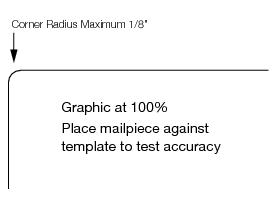
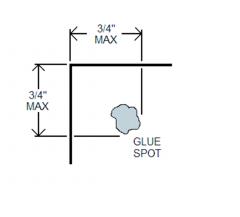
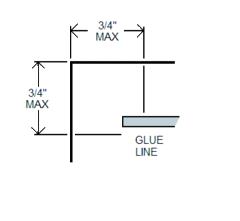
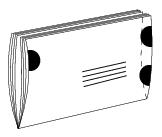
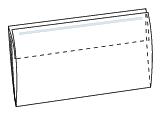

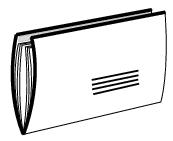
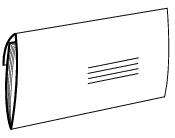
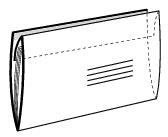
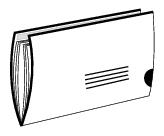

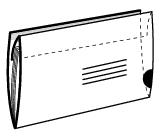

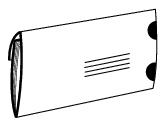
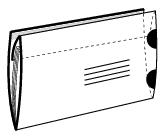
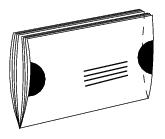
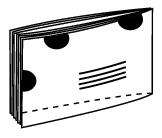
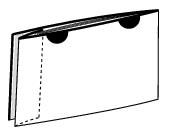
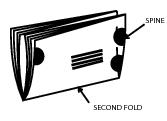 Vertical Spine
Vertical Spine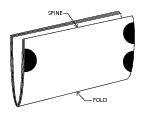 Horizontal Spine
Horizontal Spine